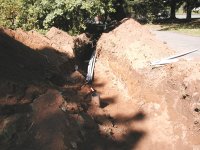lhfarm
Veteran Member
This is the continuation of my on going project to get power to the barn. To date, I've had two estimates that differ by $800 and have now called the power company for their advice. The power company, based on a phone conversation, is going to recommend a new 320 amp meter base and a 200 amp cutoff at the meter. For background the power comes into the garage, where the meter is located. 200 amp service runs under ground into the house.
The first bid was no conduit, 2/0 feed from a breaker in the garage panel. Second bid is for conduit, but basically the same setup. The power company says no less than 4/0 and in conduit for our soil conditions (rocks).
The cheapest trenching is $1/foot, but I've got a BH (why I'm in this forum). So I'm going to dig the trench and lay the conduit. I've search the board and found one good discussion, but I unclear of how I should proceed. Do I dig the trench (12" bucket) to the required 2' depth and then start assembling the conduit (2" 10' sections) on the ground, then lower them into the trench. Or do I glue them up in the trench? Should I dig 10', install a section (capping it to keep the dirt out) and back filling as I go?
I'm sure the part of the higher priced bid was for using the guys cable pulling equipment, because he mentioned the distance and the need for specail pulling equipment. Am I going to need him to pull the cable for me or will a rope, cable lube and my back be able to pull 4/0 that far?
Any advice appreicated. If I haven't made it clear, I'll try to answer questions too.
Thanks,
The first bid was no conduit, 2/0 feed from a breaker in the garage panel. Second bid is for conduit, but basically the same setup. The power company says no less than 4/0 and in conduit for our soil conditions (rocks).
The cheapest trenching is $1/foot, but I've got a BH (why I'm in this forum). So I'm going to dig the trench and lay the conduit. I've search the board and found one good discussion, but I unclear of how I should proceed. Do I dig the trench (12" bucket) to the required 2' depth and then start assembling the conduit (2" 10' sections) on the ground, then lower them into the trench. Or do I glue them up in the trench? Should I dig 10', install a section (capping it to keep the dirt out) and back filling as I go?
I'm sure the part of the higher priced bid was for using the guys cable pulling equipment, because he mentioned the distance and the need for specail pulling equipment. Am I going to need him to pull the cable for me or will a rope, cable lube and my back be able to pull 4/0 that far?
Any advice appreicated. If I haven't made it clear, I'll try to answer questions too.
Thanks,


